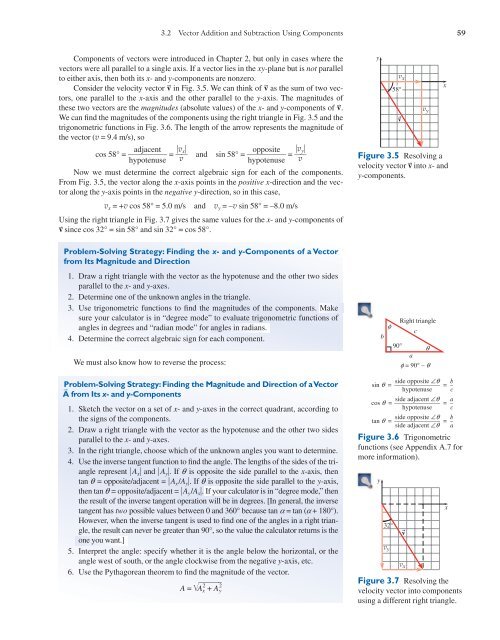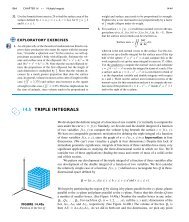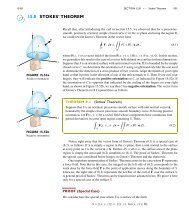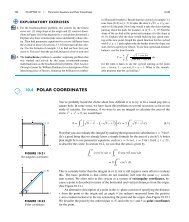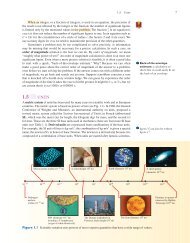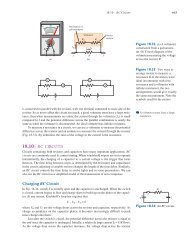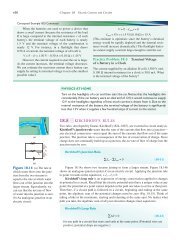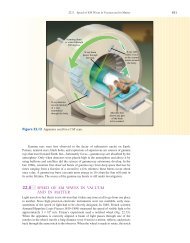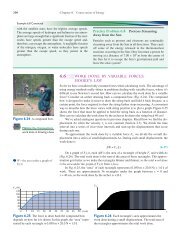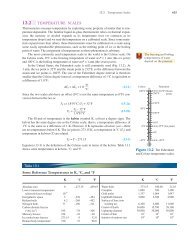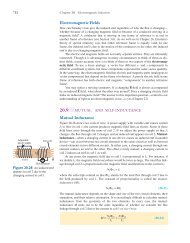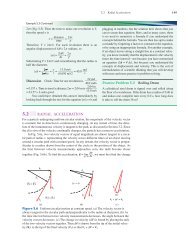Subtracting Vectors Components of a Vector
Subtracting Vectors Components of a Vector
Subtracting Vectors Components of a Vector
Create successful ePaper yourself
Turn your PDF publications into a flip-book with our unique Google optimized e-Paper software.
3.2 <strong>Vector</strong> Addition and Subtraction Using <strong>Components</strong> 59<br />
<strong>Components</strong> <strong>of</strong> vectors were introduced in Chapter 2, but only in cases where the<br />
vectors were all parallel to a single axis. If a vector lies in the xy-plane but is not parallel<br />
to either axis, then both its x- and y-components are nonzero.<br />
Consider the velocity vector v in Fig. 3.5. We can think <strong>of</strong> v as the sum <strong>of</strong> two vectors,<br />
one parallel to the x-axis and the other parallel to the y-axis. The magnitudes <strong>of</strong><br />
these two vectors are the magnitudes (absolute values) <strong>of</strong> the x- and y-components <strong>of</strong> v.<br />
We can find the magnitudes <strong>of</strong> the components using the right triangle in Fig. 3.5 and the<br />
trigonometric functions in Fig. 3.6. The length <strong>of</strong> the arrow represents the magnitude <strong>of</strong><br />
the vector (v = 9.4 m/s), so<br />
adjacent<br />
cos 58° = = v hy potenuse<br />
v x opposite<br />
and sin 58° = = v y<br />
hy potenuse<br />
v<br />
<br />
Now we must determine the correct algebraic sign for each <strong>of</strong> the components.<br />
From Fig. 3.5, the vector along the x-axis points in the positive x-direction and the vector<br />
along the y-axis points in the negative y-direction, so in this case,<br />
v x = +v cos 58° = 5.0 m/s and v y = –v sin 58° = –8.0 m/s<br />
Using the right triangle in Fig. 3.7 gives the same values for the x- and y-components <strong>of</strong><br />
v since cos 32° = sin 58° and sin 32° = cos 58°.<br />
y<br />
58°<br />
v x<br />
v<br />
v y<br />
Figure 3.5 Resolving a<br />
velocity vector v into x- and<br />
y-components.<br />
x<br />
Problem-Solving Strategy: Finding the x- and y-<strong>Components</strong> <strong>of</strong> a <strong>Vector</strong><br />
from Its Magnitude and Direction<br />
1. Draw a right triangle with the vector as the hypotenuse and the other two sides<br />
parallel to the x- and y-axes.<br />
2. Determine one <strong>of</strong> the unknown angles in the triangle.<br />
3. Use trigonometric functions to find the magnitudes <strong>of</strong> the components. Make<br />
sure your calculator is in “degree mode” to evaluate trigonometric functions <strong>of</strong><br />
angles in degrees and “radian mode” for angles in radians.<br />
4. Determine the correct algebraic sign for each component.<br />
We must also know how to reverse the process:<br />
b<br />
f<br />
90°<br />
Right triangle<br />
c<br />
q<br />
a<br />
f = 90° – q<br />
Problem-Solving Strategy: Finding the Magnitude and Direction <strong>of</strong> a <strong>Vector</strong><br />
Afrom Its x- and y-<strong>Components</strong><br />
1. Sketch the vector on a set <strong>of</strong> x- and y-axes in the correct quadrant, according to<br />
the signs <strong>of</strong> the components.<br />
2. Draw a right triangle with the vector as the hypotenuse and the other two sides<br />
parallel to the x- and y-axes.<br />
3. In the right triangle, choose which <strong>of</strong> the unknown angles you want to determine.<br />
4. Use the inverse tangent function to find the angle. The lengths <strong>of</strong> the sides <strong>of</strong> the triangle<br />
represent A x and A y . If q is opposite the side parallel to the x-axis, then<br />
tan q = opposite/adjacent = A x /A y . If q is opposite the side parallel to the y-axis,<br />
then tan q = opposite/adjacent = A y /A x . If your calculator is in “degree mode,” then<br />
the result <strong>of</strong> the inverse tangent operation will be in degrees. [In general, the inverse<br />
tangent has two possible values between 0 and 360° because tan a = tan (a + 180°).<br />
However, when the inverse tangent is used to find one <strong>of</strong> the angles in a right triangle,<br />
the result can never be greater than 90°, so the value the calculator returns is the<br />
one you want.]<br />
5. Interpret the angle: specify whether it is the angle below the horizontal, or the<br />
angle west <strong>of</strong> south, or the angle clockwise from the negative y-axis, etc.<br />
6. Use the Pythagorean theorem to find the magnitude <strong>of</strong> the vector.<br />
A = A 2 x + A<br />
2 y<br />
sin q = ______________<br />
side opposite ∠q<br />
= _ b<br />
hypotenuse c<br />
cos q = ______________<br />
side adjacent ∠q<br />
= _ a<br />
hypotenuse c<br />
tan q = ______________<br />
side opposite ∠q<br />
= _ b<br />
side adjacent ∠q a<br />
Figure 3.6 Trigonometric<br />
functions (see Appendix A.7 for<br />
more information).<br />
y<br />
32°<br />
v y<br />
v x<br />
v<br />
Figure 3.7 Resolving the<br />
velocity vector into components<br />
using a different right triangle.<br />
x


